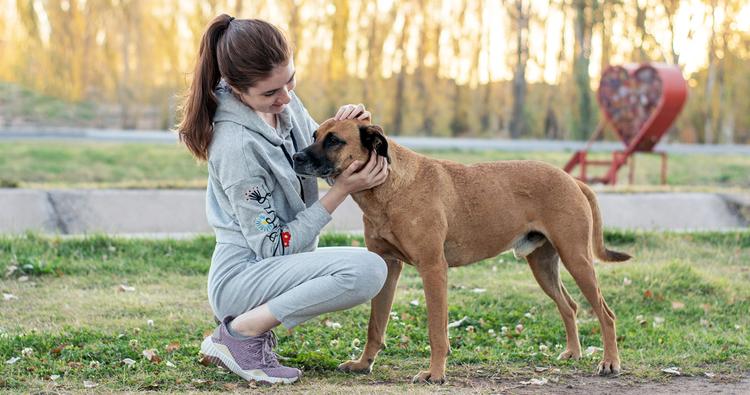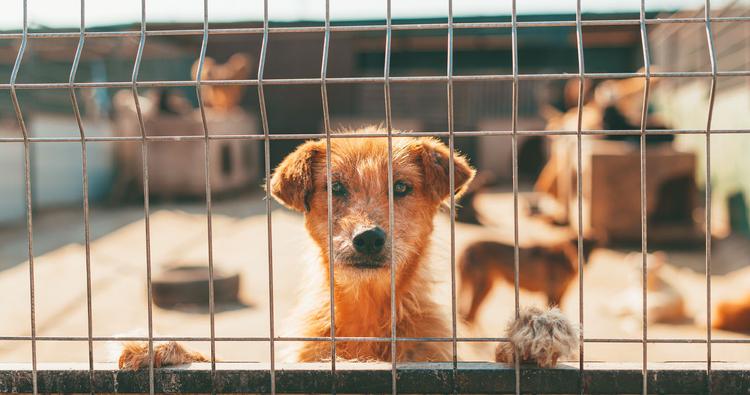Everything to Know About Adopting a Stray Dog
Stray dogs often thrive in new homes, but proper preparation and patience are key to a smooth transition
Stray dogs often thrive in new homes, but proper preparation and patience are key to a smooth transition
by Katie Koschalk, | July 29, 2024

A2 Images / Stocksy
Adopting a stray dog is a great choice — one that can transform the life of a homeless pup, reduce shelter overcrowding, and enrich your life in several incredible ways. However, transitioning from street life to a home is a significant change for a pet, and it’s normal to encounter some growing pains along the way. Stray dogs might be wary of new surroundings, be unfamiliar with household routines, and require extra patience with training and socialization.
But fear not: Many former strays have only minor behavioral issues, if any, and transition relatively easily from street living to being spoiled household pets. Even those pups who need a little more help can typically adapt well to their new lives with patience and consistent care.
To give your pup the best start in their new home, it’s important to know what to expect and how to prepare. Read on to learn the advantages of adopting a stray dog and tips to make the transition as seamless as possible.
A stray dog is a dog who lives or roams freely without a consistent home or caretaker. Stray dogs find themselves on the streets due to various circumstances, such as abandonment, getting lost, or being born to other stray dogs.
Many stray dogs are taken to shelters and rescues where they receive care and are assessed for adoption suitability. Some people even rescue stray dogs directly from the streets, offering them a loving home. Why adopt a stray dog? Here are some of the benefits of adopting a stray.
Saves a life: Strays often face numerous challenges, including finding food, avoiding dangers such as traffic or hostile animals, and coping with harsh weather conditions. “Stray dogs are more susceptible to disease, injury, or early death, so removing a dog from the streets can potentially provide them with a longer, healthier life,” says Renee Rhoades MSc, BSc, AdvDip, FFCP, founder of R+Dogs.
Strong bond: Stray dogs often show immense loyalty to their new pet parents. “While some people may say that dogs are grateful, we don’t know that for sure. But we can hypothesize that they understand a good thing when they have it, compared to living outside alone,” says Rhoades. Bonus? The joy of watching a formerly stray dog blossom into a confident, happy member of your family is incredibly rewarding and makes all your efforts worthwhile.
Supports the community: Adopting a stray helps reduce shelter overpopulation, a major problem in the U.S.
Reduces breeding: “Dogs generally have two litters per year, with upwards of 10 puppies per litter,” says Rhoades. By taking in just one stray dog and having them spayed or neutered, you could potentially prevent the birth of 20 puppies who may struggle to find homes.
Cost-effective: Adopting a stray is significantly less costly than buying a dog from a breeder. It will set you back about $50 to $350 to adopt from a shelter, versus about $1,500 to $3,500 from a breeder.
If you want to adopt a stray dog, going to an animal shelter is a great first step. Shelters have a variety of dogs in need of homes, including strays who have been rescued. Staff can provide information on the dog’s health and behavior, helping you make an informed decision. Plus, adopting from a shelter supports the community and helps reduce the number of homeless animals.
But what if you find a dog wandering alone outside, and you want to adopt them? You can’t simply take them off the street and make them part of your family. Several important steps must be followed before you can officially adopt the pup.
First, try to secure the dog by using a carrier, leash, piece of cloth, or rope to keep the animal in the area. If possible, get them into your car, a building, or your home. If you can’t secure the dog, call your local animal-control office. They can send someone out to catch the dog.
Next, make sure the dog is truly homeless. The dog could have a family that misses them, so doing the following due diligence is crucial.
Check for tags: If the dog has identification tags, call the phone number on it.
Notify animal control: If the dog does not have tags — or you can’t reach the dog’s person — call your county’s animal-control office to report the stray dog. Or take them to the closest animal shelter. Note that in most locations, it’s illegal to keep a found pet for more than 24 or 48 hours (the time varies by location) without notifying animal control.
Wait through the holding period: The dog will likely be held at a shelter for five to seven days before they’re eligible for adoption or transfer. If the dog is already part of a family, this allows the dog’s people to claim them. Some shelters will allow you to keep the stray dog during the holding period.
Make your intentions known: Upon dropping the dog off at a shelter, make it known that you would like to adopt the dog if they aren’t claimed. You can also call the shelter a few times during the dog’s holding period to check the dog’s status.
Act swiftly: Once the holding period is over, and the shelter says that you can adopt the dog, complete the adoption process quickly so you don’t miss your opportunity.
Before bringing the dog home, make sure your living space is safe and welcoming. Set up a comfortable sleeping area for your new pup, dog-proof your home and yard, and gather essential supplies such as a dog bed, food, dog treats, water bowls, toys, a leash and harness, and a crate.
Once the adoption process is complete and the dog has had a few days to settle in, take them to a veterinarian for a thorough health check-up. The vet can screen for diseases, administer necessary vaccinations, treat any immediate health issues, and provide guidance on long-term care.
If you have other pets in your home, don’t allow your new dog to interact with them until they’ve been cleared by a veterinarian.
Bringing a stray pet into your home can come with challenges, as these animals might have faced the hardships of street life. However, these factors are manageable, as most stray dogs adapt well to living in a home.
One study found that while former street dogs initially exhibited some behavioral issues, they were greatly reduced or eliminated over time. “Behavioral issues” in formerly stray dogs are usually natural dog behaviors essential for survival on the streets. These issues typically diminish as the dogs adapt to their new home and realize their needs are being met. As Rhoades says, “Unmet needs are the biggest reason why dogs have behavior problems.”
So, which challenging behaviors may appear in your newly adopted stray dog, and how can you address them? Let’s take a look.
The study mentioned above found that the most common behavioral issue was hyper-attachment, with 59 percent of dogs following their pet parents everywhere and experiencing anxiety when left alone.
To address hyper-attachment, gradually teach your dog independence by practicing short departures and rewarding calm behavior.
Stray dogs are used to roaming freely, which can lead to them trying to escape or wander — at least initially. Ensure your home and yard are secure, and provide plenty of mental and physical stimulation to keep them engaged.
In the study, 75 percent of former street dogs initially showed fearful behavior. However, 69 percent became more confident and easy-going over time. Common fears included sudden noises, thunder, vacuum cleaners, and sudden movements — issues not uncommon to even the most well-adjusted dogs.
To help reduce these fearful behaviors, provide a calm and safe environment, use positive reinforcement, and gradually expose your dog to new experiences to build their confidence.
Destructive behavior, such as chewing furniture and digging, is common as stray dogs explore their new environment and seek ways to relieve stress. The study noted an initial destructiveness rate of 32 percent, which declined to 13 percent over time.
To reduce or prevent this behavior, provide plenty of chew toys and redirect the dog’s energy to appropriate activities.
Many stray dogs have never been housetrained, but most dogs can master this quickly. Provide a consistent routine, take them outside frequently, and reward them for eliminating outdoors. Be patient and avoid punishment for accidents.
Stray dogs may have developed a strong prey drive from hunting for food. If you have small pets in your home, such as cats, introduce your new dog to your resident pet very slowly and carefully. Refer to our guide on successfully introducing a dog to a cat.
Stray dogs are used to scavenging, so they might rummage through trash or steal food. Keep food out of reach, use secure trash cans, and teach them boundaries around food with positive reinforcement and gentle redirection.
Stray dogs may guard food, toys, or other resources out of fear of scarcity, especially if you have other dogs in the home. To avoid confrontations, provide plenty of resources (toys, food, water, attention, etc.).
Use positive reinforcement to encourage good behavior. For example, if they mind their own business and don’t growl at your other dog while playing with toys or during dinnertime, offer praise and treats.
Stray dogs might struggle with being confined in crates or small spaces, often whining, pacing, or barking. Gradually acclimate them to confinement by rewarding them for positive behavior. Remember to be patient, since it may take a good amount of time to get a formerly stray dog habituated to a crate.
Former stray dogs may have never received any grooming or medical attention, so they might react with fear or aggression when being handled by professionals. Reward calm behavior with treats and praise to build their tolerance. If your new dog has trouble going to the vet, seek out a veterinary clinic that is “fear-free certified” to reduce stress.
Some former strays may bark, lunge, and pull when walking on a leash. This behavior often stems from the frustration of transitioning from freely roaming to being restricted to a leash when encountering another animal, explains Rhoades.
To address leash walking issues, Rhoades suggests walking your dog in areas away from other dogs and people, and using the longest leash legally allowed in your area. This can give your dog more autonomy to move and alleviate some of the stress they feel from restriction. Reward your dog for calm behavior and make slow adjustments as they progress.
To get a stray dog to come to you, approach them slowly and avoid sudden movements. Use food as a lure. Crouch down to appear less threatening, speak in a soothing voice, and avoid direct eye contact, as it can intimidate a dog.
Not all stray dogs have health issues, but many may suffer from parasites, infections, or malnutrition due to their time on the streets. It’s crucial to take any stray dog to a vet for a thorough check-up to ensure they receive the necessary care and treatment.
To help a formerly stray dog adjust, and establish a routine for feeding, walking, and playtime. Use positive reinforcement to encourage desired behaviors. Gradually introduce the dog to new areas and people, letting them acclimate at their own pace.

Katie Koschalk is a freelance writer based in Northern California. Fusing her love and knowledge of animals with her journalism degree and years of professional writing, Katie is dedicated to improving the lives of pets and their caretakers by sharing helpful and accurate information. When she’s not at her desk, you can find her exploring trails with her Aussie, Hunter, cooking plant-based meals, and talking to her two cats, Jax and Sadie, in really ridiculous voices.

Rehome

Rehome

Rehome


Shelters & Rescue
Read on for the grim statistics and hopeful solutions to this national problem plaguing shelters and rescues alike

Adoption Advice
Wondering when to get your pet spayed/neutered? Learn more about the process and the optimal age to get your pet fixed.

Shelters & Rescue
If you suspect animal cruelty in your community, here’s how you can help stop the mistreatment as soon as possible.

Adoption Advice
From avoiding behavior issues to preventing unwanted pups, there are several reasons why it makes a whole lot of sense.
